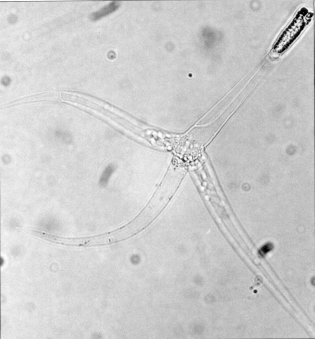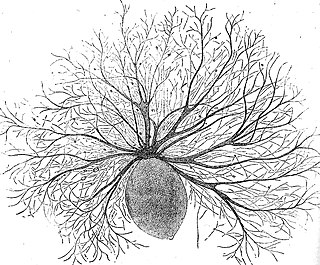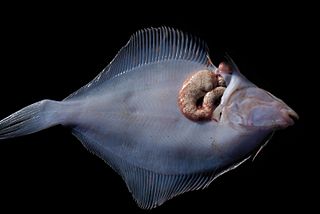Related Research Articles

Ichthyophthirius multifiliis, often termed "Ich", is a parasitic ciliate described by the French parasitologist Fouquet in 1876. Only one species is found in the genus which also gave name to the family. The name literally translates as "the fish louse with many children". The parasite can infect most freshwater fish species and, in contrast to many other parasites, shows low host specificity. It penetrates gill epithelia, skin and fins of the fish host and resides as a feeding stage inside the epidermis. It is visible as a white spot on the surface of the fish but, due to its internal microhabitat, it is a true endoparasite and not an ectoparasite.
Perkinsus marinus is a species of alveolate belonging to the phylum Perkinsozoa. It is similar to a dinoflagellate. It is known as a prevalent pathogen of oysters, causing massive mortality in oyster populations. The disease it causes is known as dermo or perkinsosis, and is characterized by the degradation of oyster tissues. The genome of this species has been sequenced.

Myxobolus cerebralis is a myxosporean parasite of salmonids that causes whirling disease in farmed salmon and trout and also in wild fish populations. It was first described in rainbow trout in Germany in 1893, but its range has spread and it has appeared in most of Europe, the United States, South Africa, Canada and other countries from shipments of cultured and wild fish. In the 1980s, M. cerebralis was found to require a tubificid oligochaete to complete its life cycle. The parasite infects its hosts with its cells after piercing them with polar filaments ejected from nematocyst-like capsules. This infects the cartilage and possibly the nervous tissue of salmonids, causing a potentially lethal infection in which the host develops a black tail, spinal deformities, and possibly more deformities in the anterior part of the fish.

Velvet disease is a fish disease caused by dinoflagellate parasites of the genera Amyloodinium in marine fish, and Oodinium in freshwater fish. The disease gives infected organisms a dusty, brownish-gold color. The disease occurs most commonly in tropical fish, and to a lesser extent, marine aquaria. Periodic use of preventive treatments like aquarium salt can further deter parasites. Regular monitoring, attentive care, and preventive measures collectively contribute to keeping fish healthy and velvet-free.
Kudoa thyrsites is a myxosporean parasite of marine fishes. It has a worldwide distribution, and infects a wide range of host species. This parasite is responsible for causing economic losses to the fisheries sector, by causing post-mortem "myoliquefaction", a softening of the flesh to such an extent that the fish becomes unmarketable. It is not infective to humans.
Infectious salmon anemia (ISA) is a viral disease of Atlantic salmon caused by Salmon isavirus. It affects fish farms in Canada, Norway, Scotland and Chile, causing severe losses to infected farms. ISA has been a World Organisation for Animal Health notifiable disease since 1990. In the EU, it is classified as a non-exotic disease, and is monitored by the European Community Reference Laboratory for Fish Diseases.
White spot syndrome (WSS) is a viral infection of penaeid shrimp. The disease is highly lethal and contagious, killing shrimp quickly. Outbreaks of this disease have wiped out the entire populations of many shrimp farms within a few days, in places throughout the world.

A xenoma is a growth caused by various protists and fungi, most notably microsporidia. It can occur on numerous organisms; however is predominantly found on fish.

Cryptocaryon irritans is a species of ciliates that parasitizes marine fish, causing marine white spot disease or marine ich. It is one of the most common causes of disease in marine aquaria.
Photobacterium is a genus of gram-negative, oxidase positive and catalase positive bacteria in the family Vibrionaceae. Members of the genus are bioluminescent, that is they have the ability to emit light.

Protozoan infections are parasitic diseases caused by organisms formerly classified in the kingdom Protozoa. These organisms are now classified in the supergroups Excavata, Amoebozoa, Harosa, and Archaeplastida. They are usually contracted by either an insect vector or by contact with an infected substance or surface.

Like humans and other animals, fish suffer from diseases and parasites. Fish defences against disease are specific and non-specific. Non-specific defences include skin and scales, as well as the mucus layer secreted by the epidermis that traps microorganisms and inhibits their growth. If pathogens breach these defences, fish can develop inflammatory responses that increase the flow of blood to infected areas and deliver white blood cells that attempt to destroy the pathogens.
Megalocytivirus is a genus of viruses in the family Iridoviridae and one of three genera within this family which infect teleost fishes, along with Lymphocystivirus and Ranavirus. Megalocytiviruses are an emerging group of closely related dsDNA viruses which cause systemic infections in a wide variety of wild and cultured fresh and saltwater fishes. Megalocytivirus outbreaks are of considerable economic importance in aquaculture, as epizootics can result in moderate fish loss or mass mortality events of cultured fishes.
Orchitophrya stellarum is a species of single-celled marine ciliates, a member of the class Oligohymenophorea. It is found living freely in the north Atlantic and Pacific Oceans but is also parasitic, being found inside the gonads of starfish.
Amyloodinium ocellatum is a cosmopolitan ectoparasite dinoflagellate of numerous aquatic organisms living in brackish and seawater environments. The dinoflagellate is endemic in temperate and tropical areas, and is capable of successfully adapting to a variety of different environments and to a great number of hosts, having been identified in four phyla of aquatic organisms: Chordata, Arthropoda, Mollusca and Platyhelminthes. Moreover, it is the only dinoflagellate capable of infecting teleosts and elasmobranchs.
Scuticociliatia is a subclass of ciliates in the class Oligohymenophorea. Its members are called scuticociliates. These unicellular eukaryotes are microorganisms that are usually free-living and can be found in freshwater, marine, and soil habitats. Around 20 members of the group have been identified as causative agents of the disease scuticociliatosis, in which the ciliates are parasites of other marine organisms. Species known to be susceptible include a broad range of teleosts, seahorses, sharks, and some crustaceans. Since 2022 there have also been several reports that scuticociliates might be responsible for mass die-off events of sea urchins across the world's oceans.

Uronematidae is a family of ciliates in the order Philasterida.
Miamiensis avidus is a species of unicellular marine eukaryote that is a parasite of many different types of fish. It is one of several organisms known to cause the fish disease scuticociliatosis and is considered an economically significant pathogen of farmed fish. M. avidus is believed to be the cause of a 2017 die-off of fish and sharks in the San Francisco Bay.

Philasterides dicentrarchi is a marine protozoan ciliate that was first identified in 1995 after being isolated from infected European sea bass reared in France. The species was also identified as the causative agent of outbreaks of scuticociliatosis that occurred between summer 1999 and spring 2000 in turbot cultivated in the Atlantic Ocean. Infections caused by P. dicentrarchi have since been observed in turbot reared in both open flow and recirculating production systems. In addition, the ciliate has also been reported to cause infections in other flatfishes, such as the olive flounder in Korea and the fine flounder in Peru, as well as in seadragons, seahorses, and several species of sharks in other parts of the world.
Philasterides is a genus of ciliates in the order Philasteridae.
References
- 1 2 3 4 5 6 7 Jung, Sung-Ju; Woo, Patrick T.K. (2012). "Chapter 5: Miamiensis avidus and related species". In Woo, Patrick T.K.; Buchmann, Kurt (eds.). Fish parasites: pathobiology and protection . Wallingford, Oxfordshire: CABI. pp. 73-91. ISBN 9781845938062.
- 1 2 Jung, SJ; Kitamura, SI; Song, JY; Oh, MJ (18 January 2007). "Miamiensis avidus (Ciliophora: Scuticociliatida) causes systemic infection of olive flounder Paralichthys olivaceus and is a senior synonym of Philasterides dicentrarchi". Diseases of Aquatic Organisms. 73 (3): 227–234. doi: 10.3354/dao073227 . PMID 17330742.
- ↑ Cummings, Sean (May 28, 2024). "Mysterious sea urchin plague is spreading through the world's oceans". Science. Retrieved June 17, 2024.
- 1 2 Yokoyama, Hiroshi; Itoh, Naoki; Ogawa, Kazuo (2015). "Fish and Shellfish Diseases Caused by Marine Protists". In Ohtsuka, Susumu; Suzaki, Toshinobu; Horiguchi, Takeo; Suzuki, Noritoshi; Not, Fabrice (eds.). Marine Protists: Diversity and Dynamics. Springer. pp. 533–550. ISBN 9784431551300.
- ↑ Paramá, A; Iglesias, R; Álvarez, M.F; Leiro, J; Aja, C; Sanmartı́n, M.L (March 2003). "Philasterides dicentrarchi (Ciliophora, Scuticociliatida): experimental infection and possible routes of entry in farmed turbot (Scophthalmus maximus)". Aquaculture. 217 (1–4): 73–80. Bibcode:2003Aquac.217...73P. doi:10.1016/S0044-8486(02)00523-9.
- ↑ Song, JY; Kitamura, SI; Oh, MJ; Kang, HS; Lee, JH; Tanaka, SJ; Jung, SJ (12 February 2009). "Pathogenicity of Miamiensis avidus (syn. Philasterides dicentrarchi), Pseudocohnilembus persalinus, Pseudocohnilembus hargisi and Uronema marinum (Ciliophora, Scuticociliatida)". Diseases of Aquatic Organisms. 83 (2): 133–143. doi: 10.3354/dao02017 . PMID 19326794.
- ↑ Stidworthy, M. F.; Garner, M. M.; Bradway, D. S.; Westfall, B. D.; Joseph, B.; Repetto, S.; Guglielmi, E.; Schmidt-Posthaus, H.; Thornton, S. M. (17 June 2013). "Systemic Scuticociliatosis (Philasterides dicentrarchi) in Sharks". Veterinary Pathology. 51 (3): 628–632. doi: 10.1177/0300985813492800 . PMID 23774745.
- ↑ Shaban, Bigad; Witte, Rachel; Horn, Michael. "Thousands of Sharks, Other Sea Life Mysteriously Die in San Francisco Bay". NBC Bay Area. Retrieved 25 November 2017.